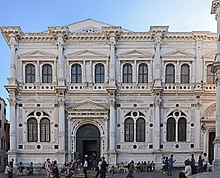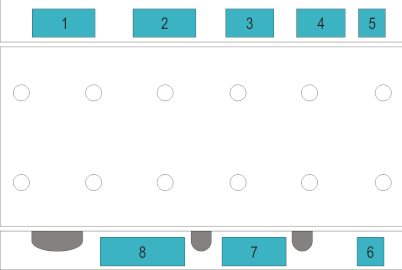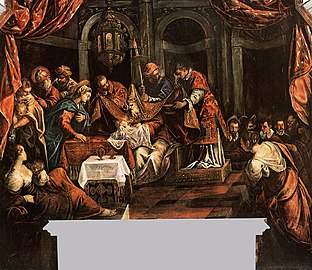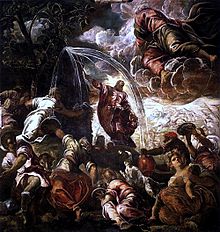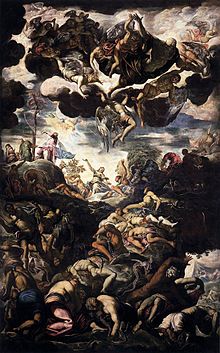Scuola Grande di San Rocco

The Scuola Grande di San Rocco is the best preserved of the six large Scuole (literally "schools", meaning the brotherhoods that carry it) in Venice and is located in the San Polo district ( sestiere ) diagonally across from the Church of San Rocco , behind the apse of Santa Maria Gloriosa dei Frari . It is especially famous for its rich furnishings with a cycle of 56 paintings by Jacopo Tintoretto , which the painter created between 1564 and 1588 and which are counted among his greatest masterpieces. The pictures served the confreres as catechesis , and Tintoretto himself had been a member of the fraternity since 1565.
history
From the 13th century onwards, charitable brotherhoods arose in Venice, the largest of which, the Scuole grandi , built palatial guild buildings for representation and social institutions.
The Scuola was founded from two brotherhoods after the plague of 1477 and named after Saint Rochus of Montpellier , who dedicated himself to caring for the sick and those suffering from the plague and who himself was healed from the plague. The Brotherhood of Saint Roch of Montpellier had its first seat in the Church of San Zulian , later in Santa Maria Gloriosa dei Frari and was officially recognized in 1478 for the practice of nursing . In 1485 the relics of Saint Roch, who was buried in Montpellier , came into the possession of the brotherhood from southern France.
In the 15th century the brotherhood became the wealthiest in Venice because of the relics. After much back and forth, the Franciscans of the Frari Church gave the Scuola a piece of land behind their monastery and moved the Scuola to its current location. In 1489 the Scuola first built a small, modest building. This old Scuola ( Scoletta ) is hidden between the Scuola Grande , the Church of San Rocco and the choir of Santa Maria Gloriosa dei Frari on Campo di San Rocco , which is bordered by these buildings. The Banca della Scuola decided to build a dignified seat and, thanks to the wealth of the brotherhood, it was decided to decorate the rooms of the Scuola appropriately.
In 1489 the foundation stone for the Church of San Rocco was laid. In 1517 the construction of the new brotherhood house began under Bartolomeo Bon II, Procurator of San Marco. He was followed in 1524 by Sante Lombardo, son of Tullio Lombardo , as site manager. From 1527 until his death Antonio Abbondi , known as Scarpagnino, took over the construction management and built the stairwell. In 1550 Gian Giacomo de 'Grigi was commissioned to design the facade in an elaborate way in order to compete with the Scuola Grande della Misericordia , which was under construction . The facades of both buildings were redesigned again between 1765 and 1771 by Bernardino Maccaruzzi .
The Scuola grande di San Rocco was the only one to escape the dissolution of all scuoles ordered by Napoleon at the urging of the citizens . At the end of the 18th century she had about 350 capitular friars and an annual income of about 60,000 ducats. Its capital, which at that time was worth well over a million ducats, was stolen by the French in 1797 - like all other Venetian capital.
facade
The facade is structured with strong columns, pilasters and cornices. In the lower part there are so-called "Codussi windows" and in the upper part a long row of twin windows with triangular gables. The windows, also known from the Palazzo Vendramin-Calerghi , named after the architect Mauro Codussi , show the typical Venetian connection between the traditional round arch shape and the Renaissance ideal of the rectangular window frame.
The halls of the scuola
The Scuola Grande di San Rocco has two floors, which are connected by a magnificent staircase with a three-tiered staircase built by Scarpagnino between 1544 and 1546 . The first of the two floors consists exclusively of the Sala Terrena . The second floor is divided into the large Sala Capitolare and the smaller Sala dell'Albergo .
Sala Terrena
The large three-aisled hall on the ground floor, divided by two rows of columns, covers 700 square meters and served both as an entrance hall and liturgical purposes, with its altar with the statue of St. Roch by Girolamo Campagna at the beginning of the 17th century.
The paintings by Jacopo Tintoretto in this room deal with scenes from the life of Mary and the childhood of Jesus:
- Annunciation
- Adoration of the Magi
- Escape to Egypt
- Innocent child massacre
- St. Mary Magdalene
- Saint Mary of Egypt
- clipping
- Assumption Day
- Painting by Tintorettos in the Sala Terrena
There is also a statue of St. Roch by Girolamo Campagna here .
Sala Capitolare
The Sala Capitolare (plenary hall) or Sala Superiore is the largest of the two halls on the first floor of the Scuola Grande di San Rocco in Venice .
History of equipment
Originally the Sala Superiore was furnished with tapestries, which were normally borrowed for the name festival of the patron saint, which the Scuola Grande di San Rocco had bought on August 24, 1542 "to adorn the Sala" ". However, it was already established in 1559 that the Hall needs other decoration.
It was not until May 6, 1575 that it was decided to commission the decoration of the ceiling.
On July 2, 1575, Jacopo Tintoretto offered the free execution of the central ceiling painting, the erection of the brazen serpent and completion of the work by August 16, 1576, the celebration of the name of St. Rochus . On January 13, 1577, the Scuola accepted his offer to complete the two other central ceiling paintings only against reimbursement of the material costs and to put his wages at the discretion of the Scuola depending on the appreciation of his work. On March 25, 1577, before the work was completed, Tintoretto extended his offer to complete the entire ceiling, which was also accepted. At the end of the year, Tintoretto declared that he would be willing to devote himself to decorating the scuola until the end of his life and to make 10 paintings, the altarpiece for the Sala superiore , and paintings for the ceiling of the San Rocco church. He also promised to deliver three large canvas paintings every year for the celebration of St. Rochus. He wanted to bear the cost of the colors himself, provided that he was given an annuity of 100 ducats a year in case he fell ill after the Sala superiore was completed. The Scuola accepted this proposal and appointed a three-person commission to decide on Jacopo Tintoretto's works. The agreements were kept and the decoration of the Sala Superiore was completed in the summer of 1581.
Interior
The room is equipped with a three-part altar, the altar sheet is by Tintoretto. The chancel is delimited by a balustrade with bronze grilles from the mid-18th century. Two early works by Giovanni Battista Tiepolo stand on easels in front of the balustrade : Hagar in Solitude, Comforted by the Angel and Abraham and the Angels, as well as the image of Christ Carrying the Cross , which is attributed to either Titian or Giorgione. It has 24 reliefs with scenes from the life of Saint Roch of Montpellier.
Walls and ceiling
First the pictures on the ceiling - three main pictures and ten oval accompanying pictures - which are clamped into the carved and gilded coffered ceiling, were completed. The pictorial program comes from the Old Testament. Events from the story of Moses are told in the three large pictures : the water miracle in the desert , the erection of the brazen serpent as a prelude to the crucifixion of Christ and the rain of the Manna . The smaller accompanying pictures also show events from the Old Testament, all of which can be read as Old Testament parallels to the life and death of Jesus. The pictures on the walls show events from the life of Jesus, including the Adoration of the Shepherds , the Baptism of Jesus , the Resurrection of Christ , and the prayer on the Mount of Olives .
Like the Sala dell'Albergo, the Sala Superiore is also covered by a splendid, gilded wooden coffered ceiling, the paintings of which are by Jacopo Tintoretto.
Sala dell'Albergo
The walls and ceiling of the Sala dell'Albergo are decorated with canvas paintings by Tintoretto.
literature
- Reclam's art guide Italy. Vol 2. Northern Italy East. Stuttgart 1965.
- Raban von der Malsburg: Architecture of the Scuola Grande di San Rocco in Venice . Doctoral thesis, Heidelberg University. Heidelberg 1976.
- Ulrich Willmes: Studies at the Scuola di San Rocco in Venice. Scaneg publishing house, Munich 1985.
- Astrid Zenkert: Tintoretto in the Scuola di San Rocco. Ensemble and effect. Tübingen 2003.
Web links
- Website of the Scuola di San Rocco (Italian, English)
- Jan-Christoph Rößler, Venice: Scuola Grande di San Rocco (venedig.jc-r.net)
Coordinates: 45 ° 26 ′ 11.9 " N , 12 ° 19 ′ 30.2" E
